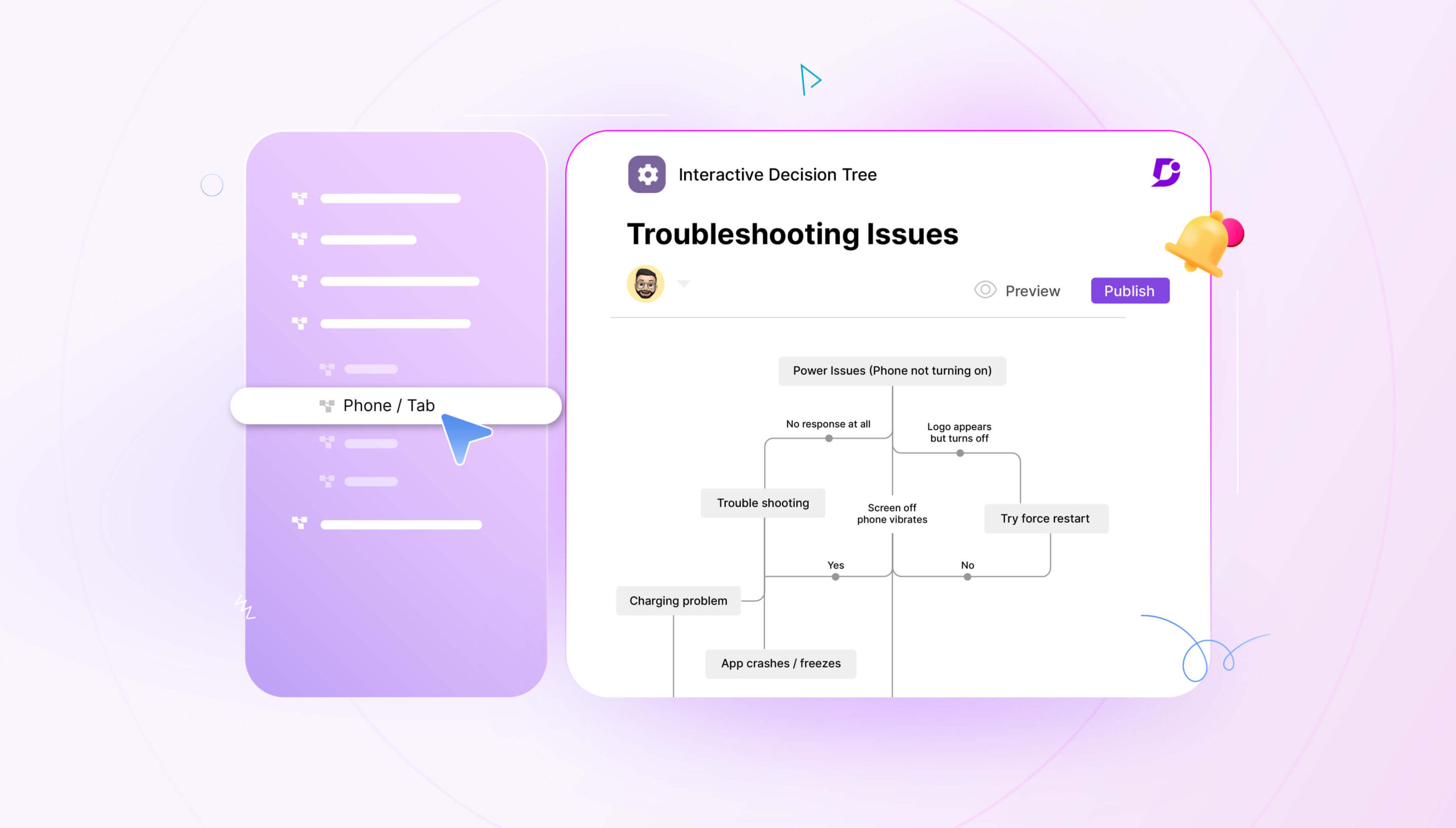Seeing the growing trends towards remote work, team collaboration is becoming a hotter topic than ever. How can colleagues stay connected and in sync when they’re working from different locations? Location-specific challenges like not being able to drop by someone’s desk for a chat is increasing the pressure on team collaboration tools to fill the gap.
As the world moves towards digital-first, the best collaboration tools are the ones that are easy to use and provide a solid replacement for in-person contact. They make employees forget that they are separated by distance and it is less effort to use the tool than fire off an email.
Even teams that work in the same office need online collaboration software to share knowledge, keep track of projects and share files. No one in the modern age can get by without digital tools to help them collaborate.
Team collaboration tools mean moving beyond email to find a way to help employees collaborate more effectively. As project complexity grows, you find a need for more robust tools that help employees to connect with one another.
What is Team Collaboration?
Team collaboration happens when groups of employees are working in harmony to achieve the same business goals. Instead of everyone striving for individual objectives, the team is looking beyond their personal viewpoint to what is good for the company. A good example of team collaboration is when teams have a shared project to work on that will provide tangible results for the business.
Team collaboration is essential because everyone has different skills to bring to the table. The company can only be successful if projects and processes are a group effort, and are aligned with business strategy. It requires the ability to share ideas and think creatively, breaking new ground to solve each new problem.
Employees must be motivated to move beyond individual achievement and unite under a shared purpose. Team collaboration is a combination of culture, processes and technology that unite to produce an environment that encourages working together.
Importance of Team Collaboration Tools in Organizations
There are many reasons why team collaboration is important to organizations.
Improves Productivity
When teams are working together effectively their productivity is enhanced. They can achieve more than any one individual could accomplish alone and tackle much bigger projects. Having the right tools means they have a fast and efficient way to share information and contact other team members. Without these tools, employees will be slowed down and encounter hurdles in their projects.
Supports Informed Decision Making
With access to the right information through online collaboration tools, teams are able to make better decisions than they could do alone. There is a record of past decisions so that employees can rest assured they are not reinventing the wheel when faced with a new decision to make. Using group messaging tools, they are able to contact the right subject matter expert who can give them advice when making a decision.
Drives Action
Without a common goal, employees may have a tendency to sit around and twiddle their thumbs. Team collaboration tools drive projects forward and encourage employees to take action, because they can see what needs to be done. When they can see what their colleagues are working on, employees may be encouraged to take action and offer their skills in unexpected ways.
Enhance Working Experience
If employees are supported to collaborate with one another, this will improve satisfaction and work and enhance the overall working experience. Management has the responsibility to provide the right tools so employees can do their jobs properly, and enjoy coming to work. Struggling with outdated systems kills the employee experience and saps morale.
Optimize Workflow Process
You need the right collaboration tools in place to optimize the workflow process and enable employees to complete projects together. Employees will come to learn the proper standard for making contributions to the organization and which tools they need to effectively accomplish their goals. The workflow process means everyone knows what is expected of them and teamwork becomes more consistent.
Better Problem Solving
All new problems require an innovative solution. Collaboration tools for teams mean everyone can come together and brainstorm solutions to problems, instead of one person struggling to find the answer alone. With collaboration tools, there is a record of past solutions that employees can use as inspiration for tackling current issues. It will be easier to avoid common pitfalls and less likely that they will create further problems as a knock-on effect.
Knowledge Transfer and Skill Sharing
There is a tendency in organizations for knowledge to become hoarded by individuals. One person knows the answer and their colleagues always have to approach them if they want access to this knowledge. The right team collaboration tools open up knowledge sharing to the whole company and mean that more knowledge is made explicit and readily available. This provides untold benefits for enhancing efficiency in the workplace.

Record Keeping & Compliance
Oftentimes, it is a legal requirement to keep records and comply with regulations. Projects cannot proceed if no one is documenting vital information and sharing it with their colleagues. Companies could be in trouble without the right documentation and it’s impossible to understand past projects without the proper records in place. Employees could end up making costly mistakes that could have been avoided if teams were using digital communication tools.
Control
Employees have more control over their work when using internal collaboration tools and are able to bring order to the chaos. For example, when documenting your knowledge using a team knowledge base, administrators are able to control who has access to the documents. When using project management tools project managers are able to organize tasks and control who to delegate them to.
How Team Collaboration Tools Help Internal Communication?
Using team collaboration tools means employees can have asynchronous conversations. They can collaborate more effectively across time zones and ensure that everyone is able to participate. Even better, there is a record of the conversation so employees who missed the boat can look back and join in after the fact.
Without the right tools, internal communication becomes nearly impossible. Employees lack platforms with which to share ideas and to ask their colleagues simple questions. Team collaboration tools connect your employees even when they aren’t working from the same location and give you a centralized system for project management. Teams are able to keep track of their work and see when their projects are due for completion.
Video conferencing tools can simulate in-person meetings and enhance collaboration for all concerned. You don’t need to meet up in the office to be able to internally communicate with your colleagues when you use a product that links up your team through video.
Finding the Right Team Collaboration Tool for Internal Communication
Communication Features
First and foremost, you need communication features that will allow your employees to collaborate and exchange ideas. Whether that’s face-to-face video conferencing or asynchronous messaging, your team collaboration tools need to allow your employees to come together and work on projects. Employees can also communicate through private knowledge bases, which allow them to record their knowledge and share with others.
Private Team Network
Your team collaboration tools should not be open to the public. Your team’s knowledge is sacred and therefore should be protected by a private team network. Your teams should require a password to log in and it should be possible to revoke login details in case an employee leaves the company.
Privacy and Security
Customers across the globe should be able to trust their vendors with their data security. Team collaboration software should back itself up with robust data security and privacy practices that form an integral part of their product engineering and service delivery principles. You should be assured that your data is protected by applying multi-tiered data security models, sticking to stringent data security practices, and top data governance processes.
Control and Customization
Your tools should be your own to customize exactly what suits your team. Your team shouldn’t have to adapt to unwieldy platforms but rather find tools that fit their own unique processes. For example, in your project management software, you should be able to change your view of your tasks to find a layout that suits your team.
Cross-functionality
The best team collaboration tools integrate with your existing software to provide cross-functionality and enable your teams to collaborate without leaving the system. Without integrations, your team is simply limited to using the software in isolation without the benefits of integrations with other systems.
Ability to Work Remotely
Your team collaboration software needs to offer your team the ability to work remotely. It should work over the cloud and be accessible from any device so your team members are always connected. It shouldn’t be a requirement to download software to access the app, since your teams need to be flexible.
Top 6 Team Collaboration Tools
1. Document360: Seamless Knowledge Sharing
Inefficient communication, scattered information, and siloed knowledge are some of the biggest challenges the teams face. Document360 solves these pain points by providing a centralized, AI-powered collaboration platform where your entire team can create, manage, and access knowledge with ease.
Built for growing teams that want to boost productivity and eliminate information gaps, Document360 allows you to organize internal knowledge into structured categories and make it easily searchable. No more digging through endless messages or waiting on replies—your team finds the answers they need, when they need them.
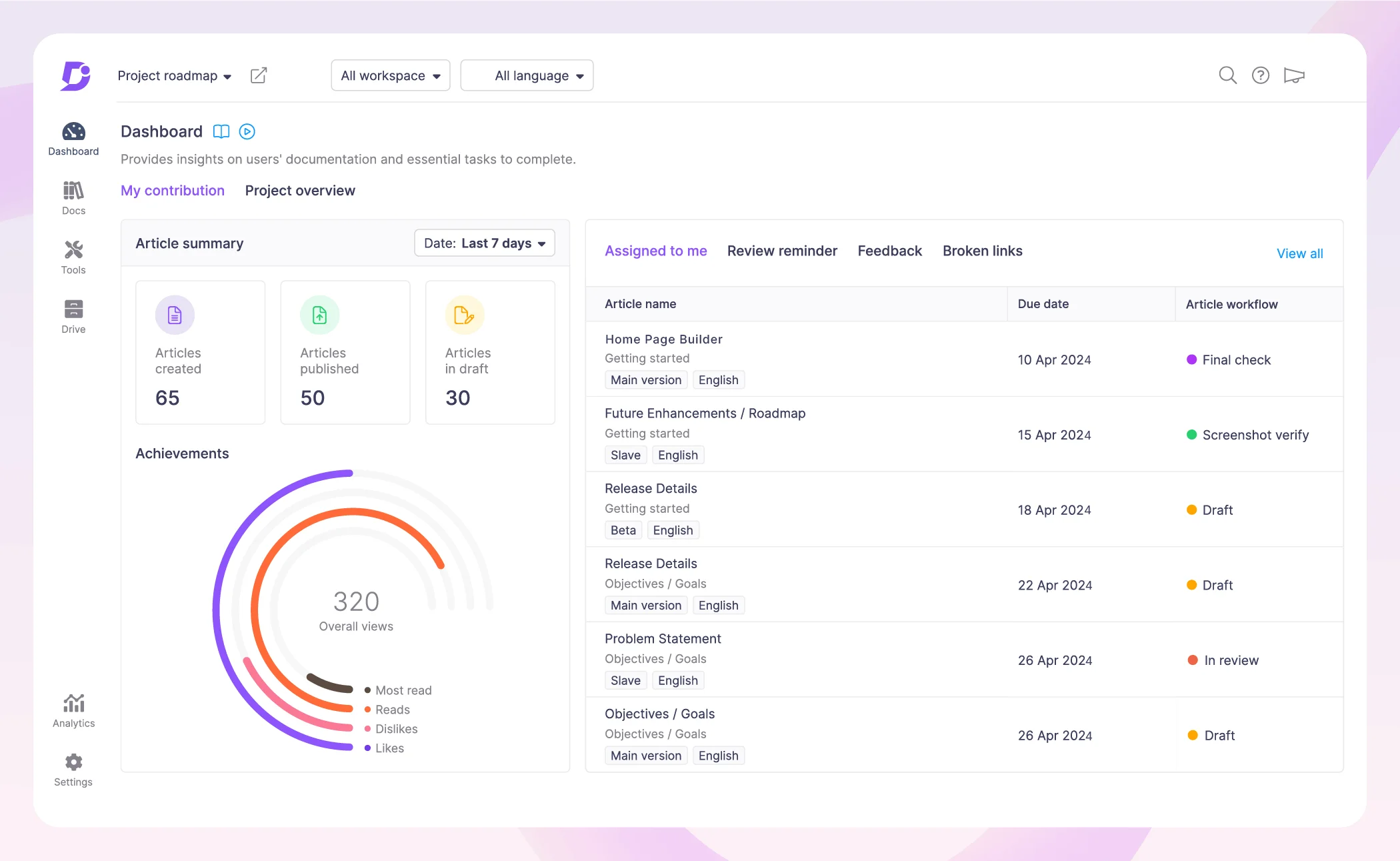
With seamless integration into tools like Microsoft Teams, Slack, and Chrome, Document360 fits right into your daily workflow. It offers powerful access control, customizable branding, advanced formatting options, and private hosting—making it ideal for teams that need both security and speed.
And to make content creation even easier, meet Eddy – the AI Writing Agent. Eddy helps your team write better, faster. It transforms prompts, transcripts, or videos into well-structured articles while following your predefined style guide rules. Eddy also suggests titles, creating FAQs, and tags—perfect for building a scalable, consistent knowledge base.
Why Document360 is the Ideal Team Collaboration Tool:
- Centralized platform for documentation and internal knowledge
- AI-powered search so employees can find answers instantly
- Eddy AI Assistant speeds up content creation and ensures tone consistency
- Category manager for organizing content across teams and departments
- Real-time integrations with collaboration platforms
- Role-based access control for secure internal documentation
Check out our video on how Document360 can streamline your internal processes!
Document360 helps your team work smarter, not harder, turning knowledge into action and collaboration into real productivity. Start your 14-day free trial and experience the difference.
Book A Demo
2. Slack: Instant Team Communication
Internal communication is not possible if teams lack a platform with which they can instantly communicate with one another. Slack is a popular instant messaging tool that allows teams to communicate asynchronously and saves conversation histories to be searched later. Conversations are organized into channels that individual users can subscribe to and benefit only from the updates they truly need.
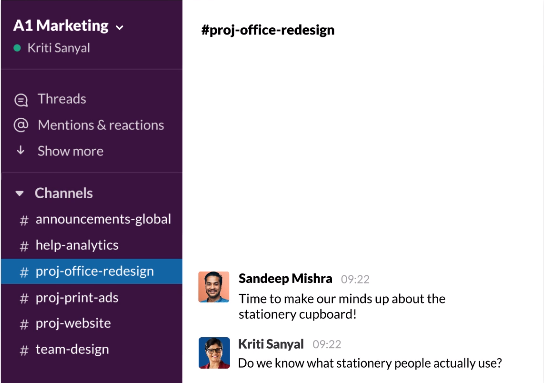
Slack comes with plenty of extra features such as video calling capabilities and integrations with hundreds of third-party tools. Slack’s Workflow Builder allows you to automate away routine tasks, saving you much-needed time and effort. The best thing about Slack is teams tend to enjoy using it but that can also be a downside – Slack can turn into a time-suck and way of procrastinating.
3. Dropbox: Reliable File Sharing
Teams that collaborate with one another need a way to securely share files. That’s why many are turning to Dropbox which is a file-sharing app that enables you to store and manage all your documents. It’s easy to send links to files to collaborators, even if they don’t have a Dropbox account. Dropbox even integrates with all your other team collaboration tools such as Slack, Asana, and Zoom, so you don’t have to leave the app to use all your favorite software.

Using the app, you can keep all your files updated and in sync from any device. The good thing about Dropbox is you can use it to send large files that wouldn’t work as email attachments. You can store all your files in a centralized place so you don’t have to worry about different versions getting confusing. Files are fully secure with Dropbox’s multiple layers of protection.
4. Asana: Organized Project Management
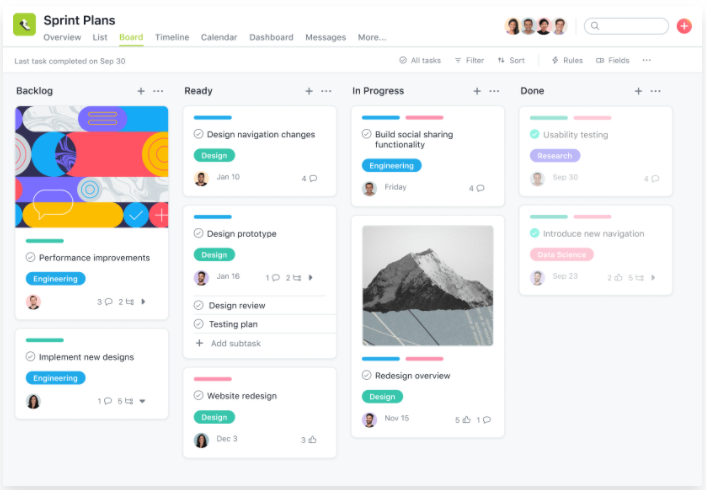
A big part of team collaboration is shared projects that numerous employees are working on together. For that, you need project management software like Asana which you can use to keep track of the progress of all the many tasks needed to complete the project. Asana is a popular solution because of its easy-to-use interface. You can choose from multiple project views and collaborate from anywhere.
In the list view, teams can see immediately what they are supposed to do, which tasks to prioritize and when work is due. Timelines show you how your work maps out over time and allows you to manage dependent and overlapping tasks. Automating repetitive tasks is possible in Asana, where you can create rules based on certain actions that trigger outcomes like assigning a task to a particular employee.
5. Zoom: Effective Video Meetings
There will be those times when employees need to collaborate face-to-face but that’s not possible when you’re all working from different locations. Zoom video conferencing software is a viable replacement for in-person contact as teams can have meetings over video link. Zoom is much more than just video conferencing software as you can benefit from the group messaging chat and sharing your screen directly within Zoom.

Zoom is preferred by teams because it is simple to use and you can share your meeting either with a personal ID or custom meeting link. Zoom syncs with your personal calendar and is accessible on any device, so you can attend your meetings on the go. You can set passcodes and waiting rooms to ensure that your meetings remain secure.
6. Kudos: Enhancing Employee Engagement
Kudos is an employee recognition platform that rewards employees for their contributions to your team. You can send recognition messages to your employees that thank them for modeling the behaviors that are valued by your team, which are explicitly named in Kudos. When employees are rewarded, they are more motivated to do good work in the future and turnover is reduced.
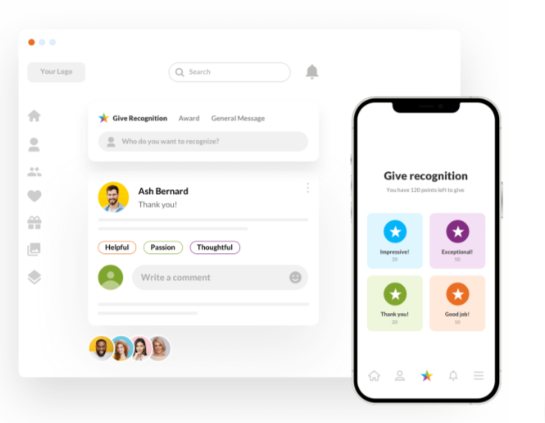
You can configure Kudos to allocate points for every recognition message received, which can be redeemed for an extensive catalog of gift cards. You can use Kudos analytics to identify trends in inter-departmental collaboration and proactively improve your culture.
7. ProofHub – Project management Tool
ProofHub is an all-in-one cloud-based project management and team collaboration tool that streamlines teamwork by providing a centralized workspace for managing all aspects of a project. It allows you to collaborate with your team members in real-time, eliminating the need for multiple applications.
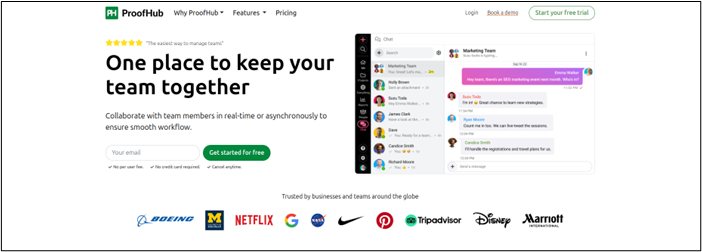
With its intuitive and customizable user-friendly interface, ProofHub offers a plethora of robust features such as in-built chat, shared notes, shared calendars, discussion boards, announcements, task management, time-tracking, online proofing tools, and more – all under a single roof, boosting team productivity.
And the best part! You get all this at a fixed flat-rate pricing model, that allows you to add as many users as you want without incurring additional costs, making it ideal for growing teams looking to improve productivity and enhance team collaboration.
Turn on Internal Communication for Better Results
Internal communication means your employees will start achieving better results as a team. Instead of working in silos, they are more connected and have a way of collaborating on projects that align with the wider goals of the business.
You can’t possibly hope to achieve your objectives if your teams aren’t working together in harmony. Team collaboration tools mean your team can more effectively work in sync than if they were solely focused on their targets.
When you choose the right tools, employees can decide between different apps for how they want to communicate. Maybe it would be best through team video chat, or they should simply create a new project in the project management app. Maybe a new Slack channel is the answer.
Whatever you settle for, it should support the business’s ability to communicate and ensure that employees can share information effectively.
Wrapping Up
Team collaboration tools are the way forward if you want to take your business to new heights of productivity and effectiveness. It’s no longer enough for employees to focus on their priorities at the expense of strategic business objectives.
You need your employees to be working together as a well-functioning team. That’s why you should consider knowledge base software like Document360, which can help your team overcome silos and share their knowledge with their colleagues. You have numerous options when it comes to sharing your content, and you can easily identify the subject matter experts in your organization.





 –
– 

